Securing both homes and businesses has become a top priority in today’s world. Installing security cameras is one of the most effective ways to ensure safety. Whether you’re protecting a residential property or a commercial space, the different types of security cameras available can be confusing.
This guide explores different types of security cameras based on connection, shape, and whether they are compatible with NVR (Network Video Recorder) or DVR (Digital Video Recorder) systems.
Types Of Security Cameras by Connectivity
Security cameras can be divided into two main types based on connectivity: Analog Cameras and IP Cameras.
Analog Cameras
Analog cameras transmit video in an analog format, typically through coaxial cables. The recorded video goes to a Digital Video Recorder (DVR) or a monitor. There, it is stored or shown. While analog cameras are a traditional option and may be more affordable, they generally lack advanced features such as video analytics, motion detection, or two-way communication. They are best suited for simple surveillance setups where basic video recording is needed.
IP Cameras
Internet Protocol (IP) cameras represent a more modern approach to surveillance. These cameras transmit video digitally over an IP network, including the internet or a local network. IP cameras are highly flexible and often have advanced features. These include HD video quality, motion detection, and two-way audio.
Unlike analog cameras, IP security cameras often do not need a DVR. They can store footage on the camera, a cloud service, or a network-attached storage device (NAS). The flexibility and quality of IP cameras make them a popular choice for modern surveillance systems.
Types Of Security Cameras by Placement
Security cameras can also be categorized by where they are intended to be used. The main types are Indoor Security Cameras, Outdoor Security Cameras, and Video Doorbells.
Indoor Security Cameras
Indoor cameras are designed to monitor homes, offices, retail stores, or other indoor environments. These cameras are compact and unobtrusive, making them easy to place strategically within a building. They often provide high-quality videos. Sometimes, they also include extra features like audio recording and motion detection. This makes them great for watching entry points, hallways, or sensitive areas.
Outdoor Security Cameras
Outdoor cameras are built to withstand the elements and provide continuous surveillance in outdoor spaces. These cameras can resist weather conditions. They have IP ratings of IP66 or higher. This means they can handle dust, rain, and extreme temperatures. Outdoor cameras are usually more extensive and durable than indoor models, ensuring reliable performance in diverse environments such as driveways, gardens, or parking lots.
Video Doorbells
A video doorbell is a device that combines a doorbell, camera, and intercom. It lets homeowners watch their front door from afar. Video doorbells have features like two-way audio and motion detection. They allow homeowners to talk to visitors and get package alerts. These doorbells can also help keep potential intruders away. These devices are an increasingly popular option for home security, providing peace of mind and convenience.
Types Of Security Cameras by Wiring
Security cameras can be classified as Wired or Wireless based on their wiring.
Wired Security Cameras
Wired cameras are physically connected to a central recording device or monitor via cables. These cameras usually use Ethernet cables, like Cat5e or Cat6, for power and video. People call this technology Power over Ethernet (PoE).
Wired cameras offer a stable connection. Many people prefer them for large installations where reliability is important. They need professional installation and become more challenging to move after someone sets them up. However, they provide continuous power and steady recording.
Wireless Security Cameras
As the name suggests, wireless cameras do not rely on physical cables for video transmission. They connect to the network via WiFi or other wireless communication protocols like Bluetooth or Zigbee.
Batteries or solar panels typically power wireless cameras, which makes installation and relocation easy. However, they may require more frequent maintenance to ensure that someone charges or replaces the batteries. Wireless cameras are great for homes and businesses where wiring can be complicated. However, their performance relies on the strength of the wireless network.
You can also read about security cameras for businesses.
Security Camera Types by Shape
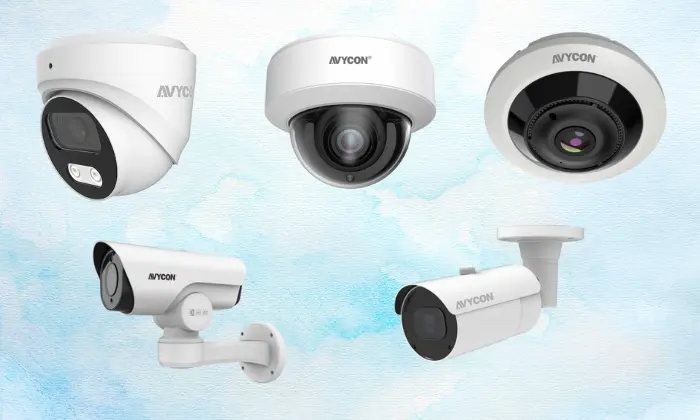
Security cameras come in various shapes, each offering unique benefits depending on the surveillance area and required coverage. Common types include Bullet Cameras, Dome Cameras, Turret Cameras, Fisheye Cameras, PTZ Cameras, Floodlight Cameras, and Hidden Cameras.
Bullet Cameras
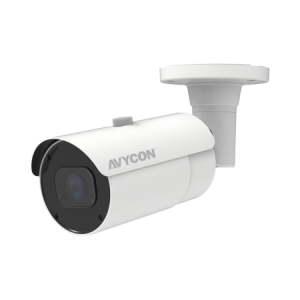
Named for their cylindrical shape, bullet cameras are one of the most common security camera types. These cameras are often placed to focus on specific areas. This makes them great for watching driveways, hallways, or outdoor spaces.
Bullet cameras are available with fixed and varifocal lenses, which provide flexibility in adjusting the field of view. However, they cannot pan or tilt unless manually adjusted.
Dome Cameras
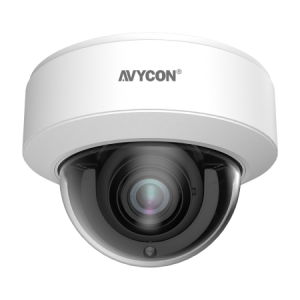
Dome cameras are encased in a dome-shaped housing, offering a sleek and discreet design. One key advantage of dome cameras is that it is hard for someone to see which way the camera is pointing. This gives a level of stealth. These cameras are often used in retail stores, offices, and homes. While they offer a wide field of view, they generally have a fixed angle unless equipped with advanced features like pan-tilt-zoom (PTZ).
Turret Cameras
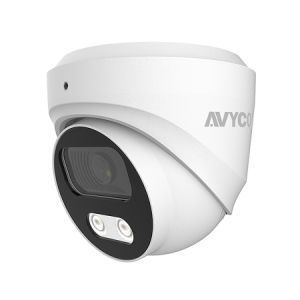
Turret cameras, sometimes called “eyeball cameras,” are known for their compact, cylindrical design. Their flat front face allows for precise, unobstructed views. These cameras are ideal for low-light settings and provide high-quality night vision. Turret cameras are popular for both indoor and outdoor use. Their simple design and flexibility make them great for homes, businesses, and commercial spaces.
Fisheye Cameras
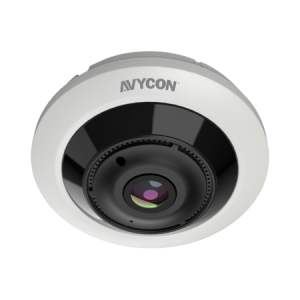
Fisheye cameras provide a comprehensive, 360-degree view. This makes them great for large spaces like warehouses, parking lots, and conference halls. These cameras have a wide-angle lens that slightly distorts the image. This design allows for full coverage of a space with fewer cameras. Fisheye cameras are especially useful for monitoring large areas with minimal blind spots.
PTZ Cameras
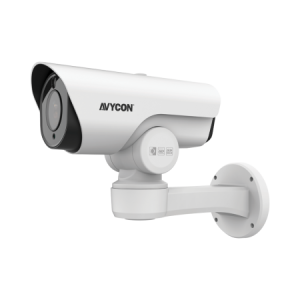
You can control pan-tilt-zoom (PTZ) cameras from a distance to pan, tilt, and zoom in on specific areas. This feature makes them ideal for monitoring larger spaces where coverage needs may change frequently. Big retail stores, stadiums, and airports often use PTZ cameras. Surveillance operators use them to track moving targets or zoom in for a closer look.
Security Camera Types by Recording Method
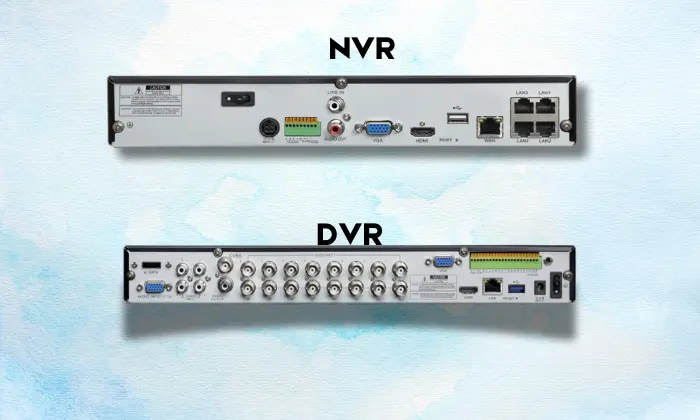
Security cameras can also be categorized by how they record and store video footage. Standard methods include NVR, DVR, and Cloud Recording.
NVR (Network Video Recorder)
NVR systems work with IP cameras and use Ethernet cables to transmit video data over a network. These systems are simple to set up. This is especially true in PoE configurations. In these setups, one cable provides both power and video. NVRs offer high-quality digital recording and are compatible with many modern security camera systems.
DVR (Digital Video Recorder)
DVR systems are designed for analog cameras, converting analog signals into digital formats before storing the footage. DVRs use coaxial cables and are more traditional than NVRs. DVR systems are usually cheaper. However, they need more advanced features. They work best for simpler surveillance setups.
Cloud Recording
Cloud-based security cameras upload footage directly to remote servers, eliminating the need for a physical recording device. Cloud storage allows users to access footage from anywhere via an internet connection. This method offers convenience and scalability, making it an excellent option for homeowners and small businesses.
Home vs. Business Security Cameras: What's the Difference?
While home and business security cameras share similar features, they differ in scale, functionality, and customization.
Home Security Cameras
Home security cameras are typically smaller and easier to install, focusing on ease of use and convenience. Features like two-way audio, smart home integration, and app-based control are often included. Home systems prioritize monitoring entry points, common areas, and outdoor spaces.
Business Security Cameras
On the other hand, business security cameras are built for larger, more complex environments. They often need more advanced features. These include remote PTZ control, larger storage capacity, and integration with current security systems. Business cameras must cover larger areas like parking lots, warehouses, and office buildings. This requires more robust hardware and software solutions.
Best Security Camera Types for Home
Choosing the right security camera for your home depends on your needs, budget, and preferences. Some popular options include:
- Wireless Security Cameras: These cameras are ideal for easy installation and flexibility. They do not need complex wiring. They provide remote access, motion detection, and two-way communication. This makes them a convenient choice for homeowners.
- Indoor Cameras: Compact and practical, indoor cameras are perfect for monitoring the inside of your home. People commonly use them to check on pets, children, or valuable areas of the house.
- Doorbell Cameras: Doorbell cameras are great for watching your front door. They offer real-time video and two-way audio. This makes it easy to talk to visitors and stop package theft.
Best Security Camera Types for Business
For businesses, the size and layout of the premises determine the ideal security setup. You need more than one camera for adequate coverage in retail stores, offices, or other large indoor spaces. Key options include:
- Security Camera Systems: These systems consist of multiple cameras linked to a central NVR (Network Video Recorder), making them suitable for businesses requiring comprehensive surveillance in larger areas. They are perfect for tracking multiple locations in real time.
- PTZ Cameras: PTZ (Pan-Tilt-Zoom) cameras provide flexibility by allowing users to remotely control the field of view. These cameras are great for watching large areas like warehouses and retail floors. They can cover a lot of space.
- Fisheye Cameras: Offering a full 360-degree view, fisheye cameras are ideal for open, large spaces such as conference rooms or store aisles. They help reduce blind spots without the need for multiple cameras.
Choosing the right type of security camera depends on your needs, environment, and budget. Various types of security cameras and features can provide the best security for your home or business. Contact CAM Security Surveillance for professional installation services of home and business security cameras in Indiana and nearby areas, and keep a close eye on your property. Our professional technicians can assist you in choosing the right type of security camera for your needs.








